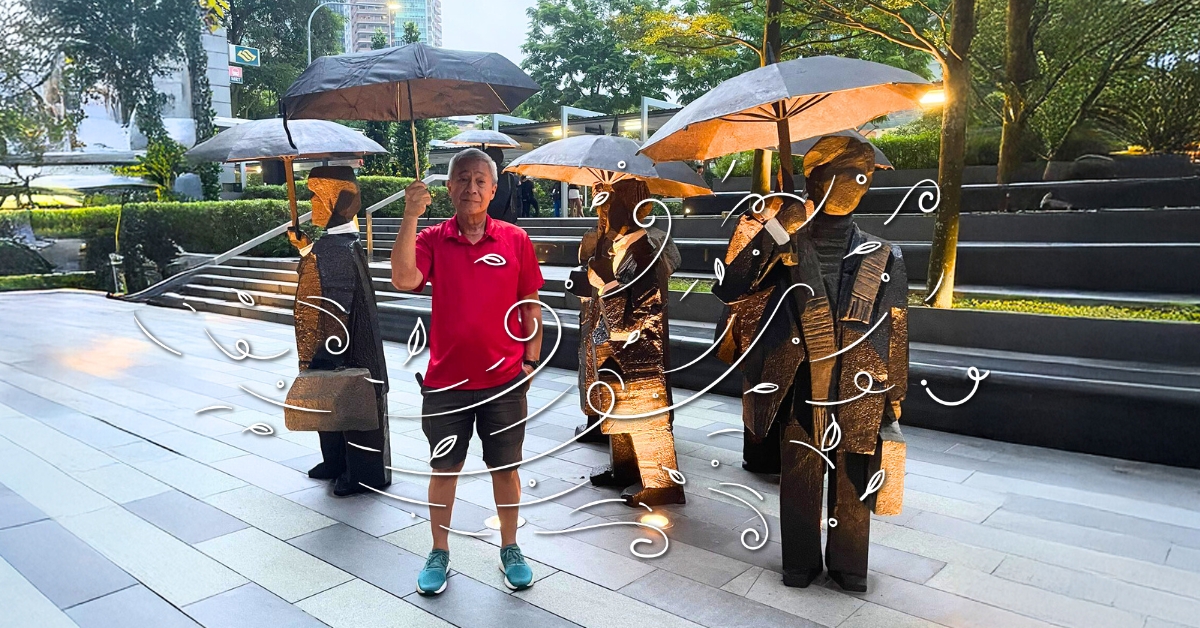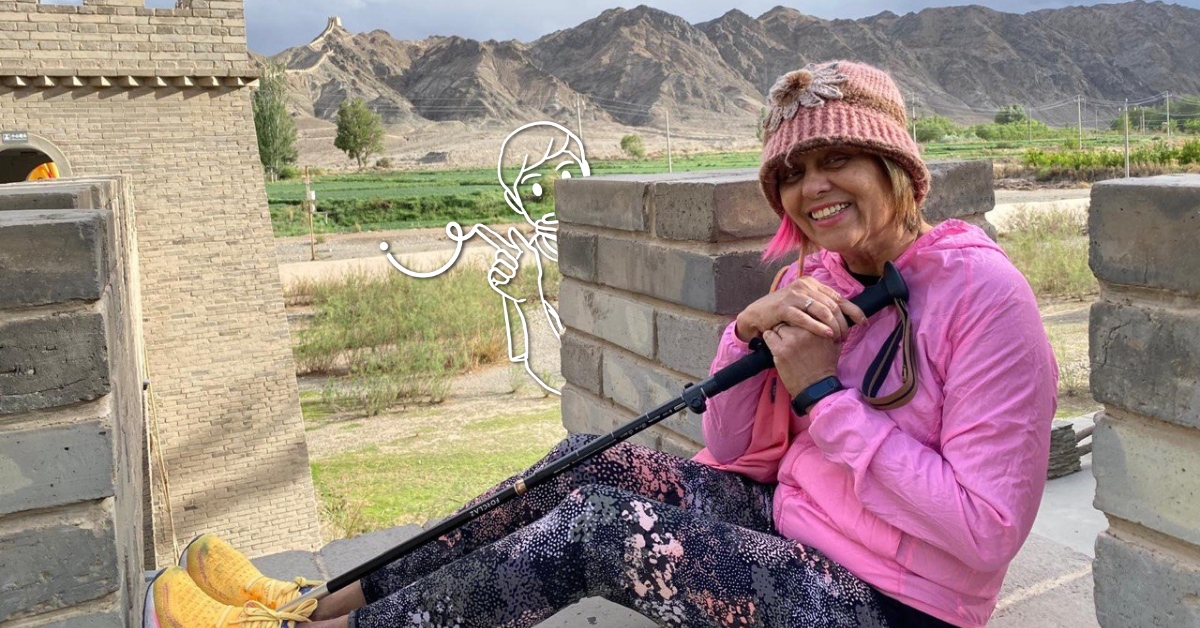
I had never been to China prior to my recent Silk Road trip from Xian to Xinjiang.
Yet it turned out to be the best time to visit, because the country’s spectacular rate of development not only awed me but contributed to my ease of covering 5,300 km in 24 days – thanks in no small part to the fantastic high-speed trains.
My objective was for my journey to parallel that of the traders on the Silk Road. Some 2,000 years ago, when Western Han Dynasty Emperor Wu sent his envoy Zhang Qian on a diplomatic mission to Central Asia, his expeditions facilitated the opening of the route, and trade and cultural exchange between the East and the West.
The traders battled harsh environmental elements travelling from Xian (formerly known as Chang’an) to the west to sell their commodities (silk, porcelain, jade, horses etc.).
They took years to cover the journey in caravans of camels, horses, and donkeys. This was dramatically depicted during our trip, not only on the large-screen videos at the museums we visited, but also in the immersive live theatre shows we watched.
One performance took place right on the sand dunes bordering the Gobi, where they even used real sand and snow as part of the theatrics on stage.
Advertisement
Now is the best time to visit China
It was also the best time to visit these charming, old, historically-rich Chinese cities on the Silk Road before rapid development catches up too much with them.
Already, I saw so many signs leading to that. China’s cities utilise facial recognition systems, smart traffic grids, and AI-driven logistics.
My good (AI) friend “Xiao Du” switched on my hotel room lights and drew the blinds without me lifting a finger.
My coach driver had mandatory 20-minute rest breaks as monitored by the GPS. And he, like all other coach drivers, was not allowed to drive on the roads between 2am and 5am for safety reasons. I felt very safe in the country.
On my journey, I walked in high temperatures, high UV conditions, and in high altitude (3,000m) areas. My face was caressed by sand and snow. My feet stood below sea level and at 4,000m in Xinjiang. But it was all worth it.
My suggestion? Best to cover the Silk Road cities in Northwest China in one trip and return for the Silk Road cities in Xinjiang. This would be less taxing for silvers.
Our Northwest China adventure
Ours was a group of friends comprising silvers 62 to 78 years old. Most of them hiked twice a week in Singapore. We were used to walking or exercising regularly.
You must have heard it said that if you intend to visit China, to not delay your adventure, because there is much walking and climbing. That couldn’t have been more accurate, as I found out.
I had always wanted to climb the Great Wall of China – the only man-made structure that can be seen from the moon.
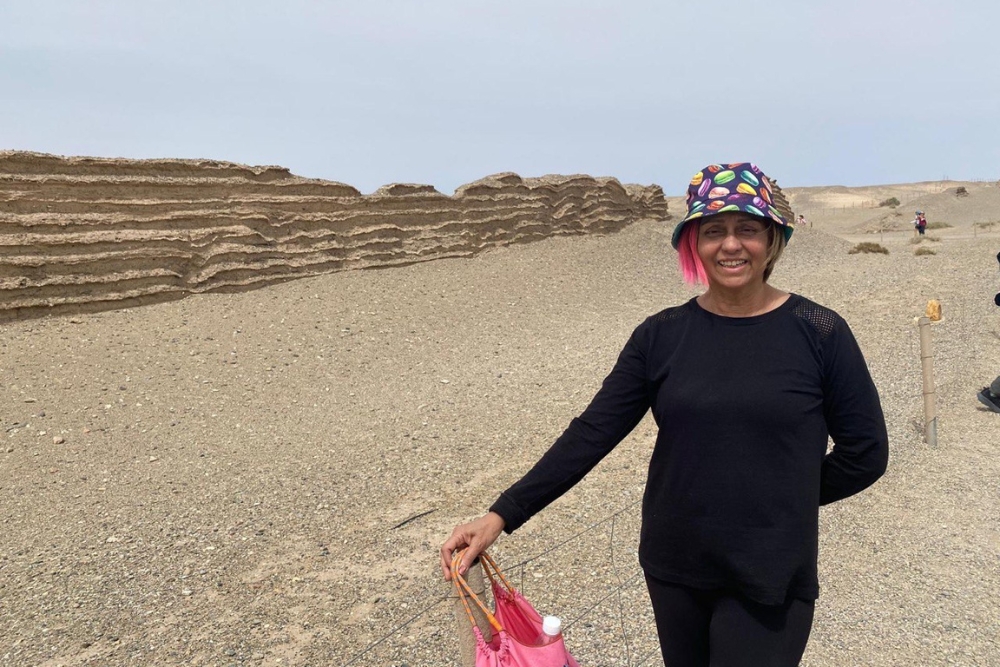
Credit: Valerie Valberg-Yeoh
I stood in awe at the western end of the Ming Great Wall at Jiayuguan Pass, with the best-preserved 750m Overhang Wall in the background, and two days later gasped at the last bastions of the 2,000-year-old Han Great Wall near Dunhuang. So glad this was covered in our itinerary. Mission accomplished.
On our self-planned journey, we visited Xian, Luoyang, Xining, Zhangye, Jiayuguan, and Dunhuang; situated in Shaanxi, Henan, Qinghai, and Gansu provinces.
As a former history teacher, I felt immense satisfaction learning more about the historical and cultural significance of these Silk Route cities first-hand.
The museums provide a plethora of information so beautifully curated and presented with the help of technology. We spent three hours in the Dunhuang museum.
Xian
The starting point of the trip was Xian (the capital of Shaanxi province), the capital of many dynasties: Western Zhou, Qin, Western Han, Sui, Northern Zhou, and Tang.
Hence, the attractions include the immaculately-preserved Ming (Dynasty) City Walls, the Terracotta Warriors and Horses Museum, and Hua Shan Mountain with its Taoist temples.
It was a steep climb up many steps to the base of the cable car station at Hua Shan for the ride but my friends chorused it was worth the climb as the views were stunning.
Luoyang
We took our first high speed train ride (2.5 hours) to Luoyang from Xian. That was quite an experience. We had to stand as close to our carriage as possible with only one minute to board the train with our luggage.

Credit: Valerie Valberg-Yeoh
Luoyang, located in present day Henan province at the confluence of the Luo River and Yellow River, was one of the oldest (5,000 years) cradles of Chinese civilization and most important cities along the ancient Silk Road.
It played a significant role in China’s cultural, economic, and religious exchanges with the west. We visited the charming old city of Luoyang (known as Luoyi), delighted to see many young visitors dressing up in period attire to have photographs taken against the beautiful backdrop.
While Chang’an (Xian) is often considered the primary eastern terminus of the Silk Road, Luoyang also served as a key starting point, especially during the Eastern Han (25-220AD) and Tang (618-908 AD) dynasties where it was the secondary capital. In total, Luoyang was the capital for 13 dynasties.
Longmen Grottoes
Many Silk Road caravans began their journeys from Luoyang carrying silk, porcelain, and other Chinese goods westward. Luoyang became a major centre for Buddhist learning when Buddhism entered China through the Silk Road.
Some of the finest examples of Buddhist art spanning 1,500 years can be seen at the famous UNESCO World Cultural Heritage site: The Longmen Grottoes. A stone carving masterpiece that took 400 years to complete (493AD).
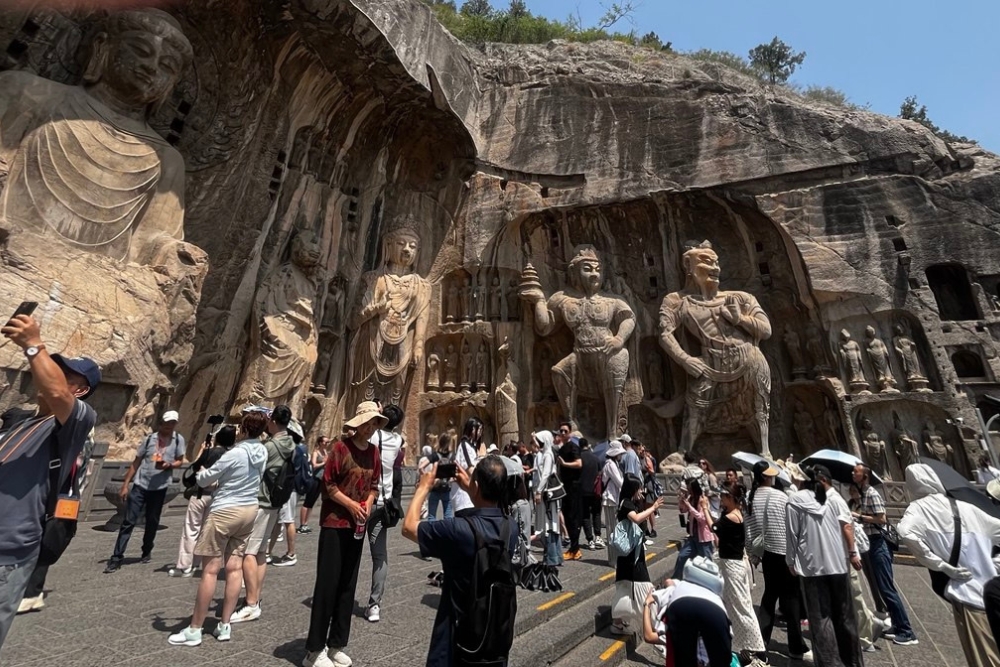
Credit: Valerie Valberg-Yeoh
The 2,300 caves showcase more than 100,000 thousand Buddha statues. Be prepared for crowds of local tourists, lots of walking, and steps.
My most breathtaking reward was looking up at the impressive 17.14m high Vairocana Buddha, supposedly modelled after China’s only female emperor, Wu Zetian.
Later, Nestorian Christianity and Zoroastrianism also reached Luoyang via the Silk Road. Merchants from Central Asia, Persia, and the Roman Empire visited Luoyang bringing goods like glass, spices, gems, and horses to trade.
Shaolin Temple
Shaolin Kungfu is said to have its roots in Buddhist Zen philosophy and since Buddhism came to China via the Silk Road, we planned a visit to the famous birthplace of Shaolin Kungfu, the Shaolin Temple/Monastery, just 50km from Luoyang.
Built in 485AD, the temple has been reconstructed many times. Go early to get a seat (not too near the stage) for the Shaolin martial arts performance by trainees, as crowds gather fast.
Many in my group who watched Kungfu movies growing up were thrilled when they were able to identify the filming locations of martial arts movies at the temple.
In the temple grounds is also a unique cemetery with pagodas marking the tombs of monks. It’s aptly named the Pagoda Forest. The Shaolin Temple and Pagoda Forest are both UNESCO World Heritage sites.
Xining
After returning to Xian, we took our second high-speed train ride (4 hours), this time to Xining.
Xining was a key stop on the Southern Silk Road where it intersected with the Hexi Corridor (a fertile stretch) and ancient Tang-Tibet Road which linked Chang’an (or Xian) to Lhasa, Nepal, and India.
It was part of the Tea-Horse Trade System where tea was exchanged for Tibetan horses. It also became a centre for Buddhist exchange with Tibet.
With Central Asia, silk, tea, porcelain, and spices were exchanged. Xining also facilitated the exchange of horses, timber, wool, salt, and precious stones from Tibet and Mongolia.
The Ming (1368-1644) and Qing (1644-1912) dynasties also used Xining as a garrison town to control trade and protect China’s western borders against nomadic tribes and Tibetan forces.
Kumbum Monastery
So from the high temperatures (30-35 degrees in May) we experienced in Luoyang the previous day, we were transported to high altitudes in Xining.
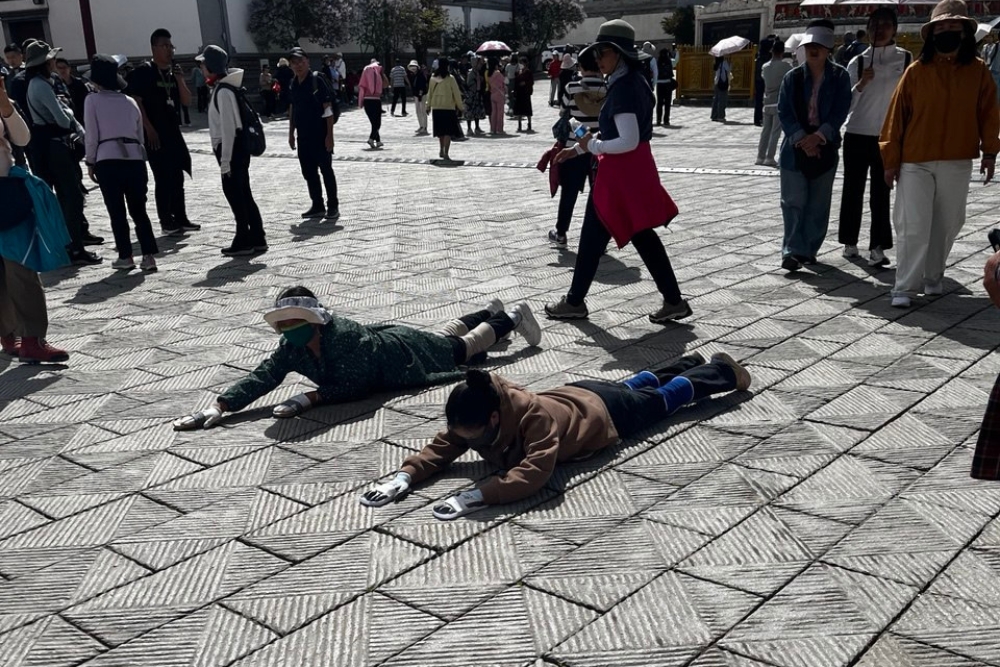
Credit: Valerie Valberg-Yeoh
We were cautioned to walk at a slower pace as we made our way to and around the Kumbum Monastery (aka Ta’er Monastery), at 2,680m elevation, an important stop for Tibetan Buddhists and Silk Road travellers. Built in 1577, the monastery is one of the sixth largest monasteries of the Yellow Hat Sect (Tibetan Buddhism).
By the end of the day, I experienced another first: high altitude sickness, albeit a mild one with some wooziness and a headache. Per the group’s advice, I popped a Panadol and it worked.
Today’s travellers to Tibet would catch the Qinghai-Tibet train (a high-elevation railway) at Xining.
Chaka Salt Lake
Chaka Lake is situated near the Southern Silk Road or Tea Horse Road. Just four hours by coach from Xining, it was an exciting stop on our itinerary.
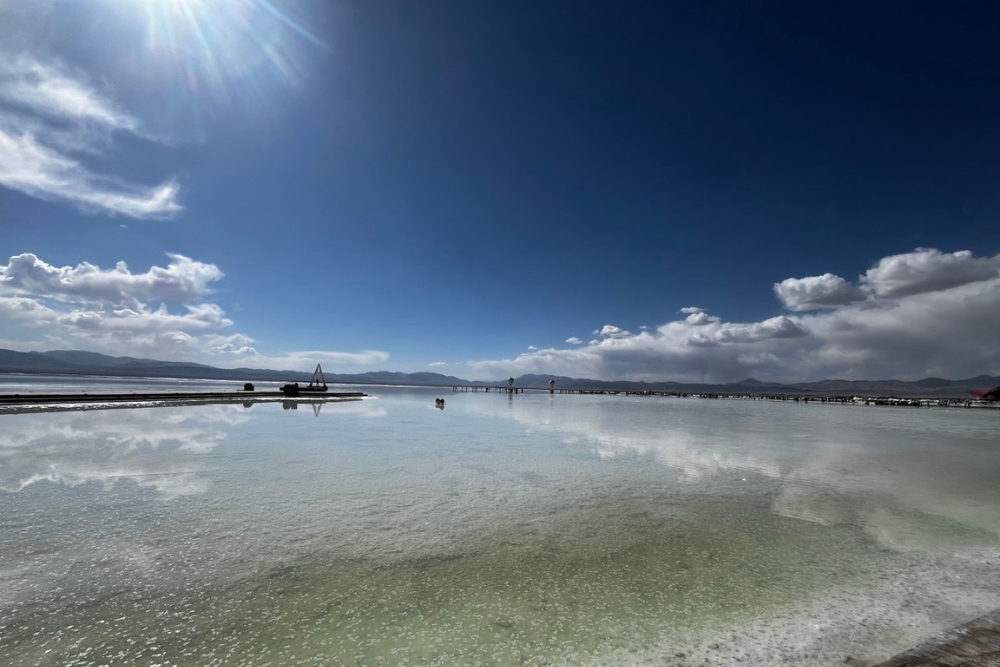
Credit: Valerie Valberg-Yeoh
Chaka Salt Lake is famous for its stunning reflective surface. Hence the name: China’s Mirror of the Sky. We almost forgot that we were still at high altitude (3,100m) once we donned our bright red fabric boots and had fun frolicking in the Salt Lake.
Salt was an item traded on the Silk Road. We were told the lake produces enough salt to supply the world for 150 years. This UNESCO Global Geopark is not to be missed for its cultural and touristic appeal.
Zhangye/Linze
Zhangye played a pivotal defensive role on the Silk Road. The Han and Tang dynasties established military garrisons in Zhangye to protect trade routes and defend against nomadic invasions. During the Ming Dynasty (1368-1644) Zhangye defended the Great Wall’s western section.
As a major marketplace, silk, porcelain, spices, jade, and horses were exchanged. Zhangye connected the nomadic tribes of the steppes with Chinese dynasties that sought high-quality steeds for their cavalry. It was also a melting pot for the Han Chinese, Tibetans, Uyghurs, and Mongols.
Spectacular shows
The following day I saw my first show in Linze county, Zhangye: Memory of Zhangye. This was the first of four shows I would watch.
I had heard so much about the spectacular theatre performances in China. I highly recommend them. I loved the special effects that simulated sandstorms, snow storms, and mirages in the Linze show.
These shows are truly an upcoming industry in themselves with the huge number of performers and supporting cast hired, as well as tech crew, creative writers, producers, directors, and production crew.
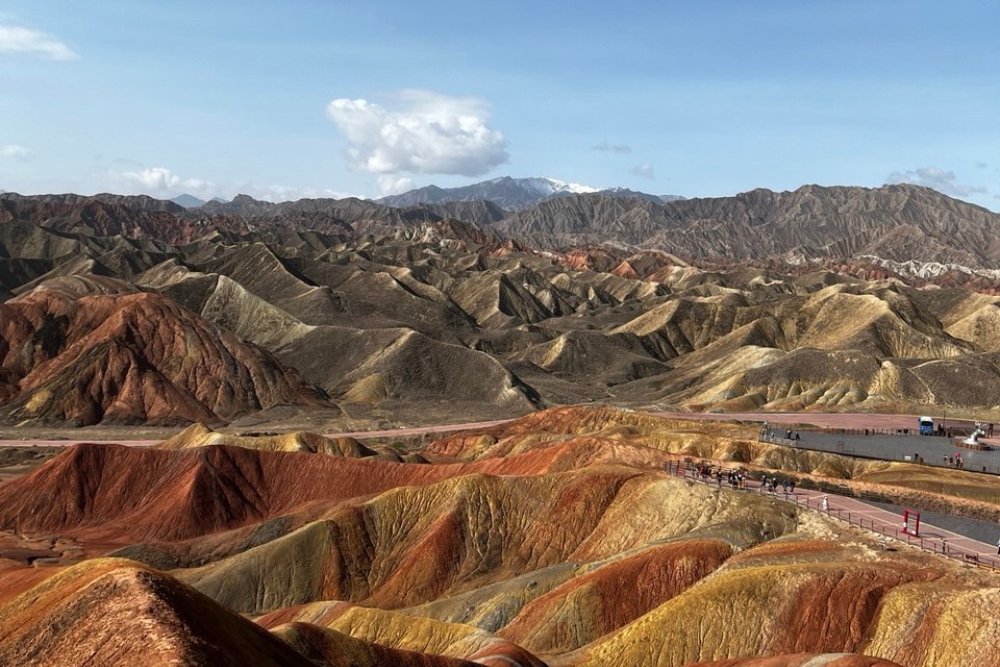
Credit: Valerie Valberg-Yeoh
The following morning we were blown away by another sight close to our hotel: the colourful layered rock formations on the famous Rainbow Mountain at the Zhangye Danxia Landform Geological Park, a UNESCO Global Geopark.
The reddish sandstone and other mineral deposits created vibrant striped patterns on the mountain. The Danxia landform is the result of geological processes over millions of years with the area once being a lake or basin.
Jiayuguan
Jiayuguan in northwestern Gansu province is home to the famous Jiayuguan Pass stretching in front of the majestic Qilian Mountains.
This pass marks the end of the western Great Wall that began in Shanhai Pass in the east; the latter being very popular with tourists. The 21,196km Great Wall is more than 2,300 years old (a nine-dynasty span).
As I stood in wonder admiring the western end of the Ming Great Wall at Jiayuguan Pass, I saw my travel buddies turn back from their climb up the wall. By golly, a sand storm was fast approaching.
We braced ourselves, covering our faces with masks and any headgear we had. It was then that we understood (at least in some part) what the Silk Road traders had to contend with. And this wasn’t going to be our only encounter with a sandstorm.
Dunhuang
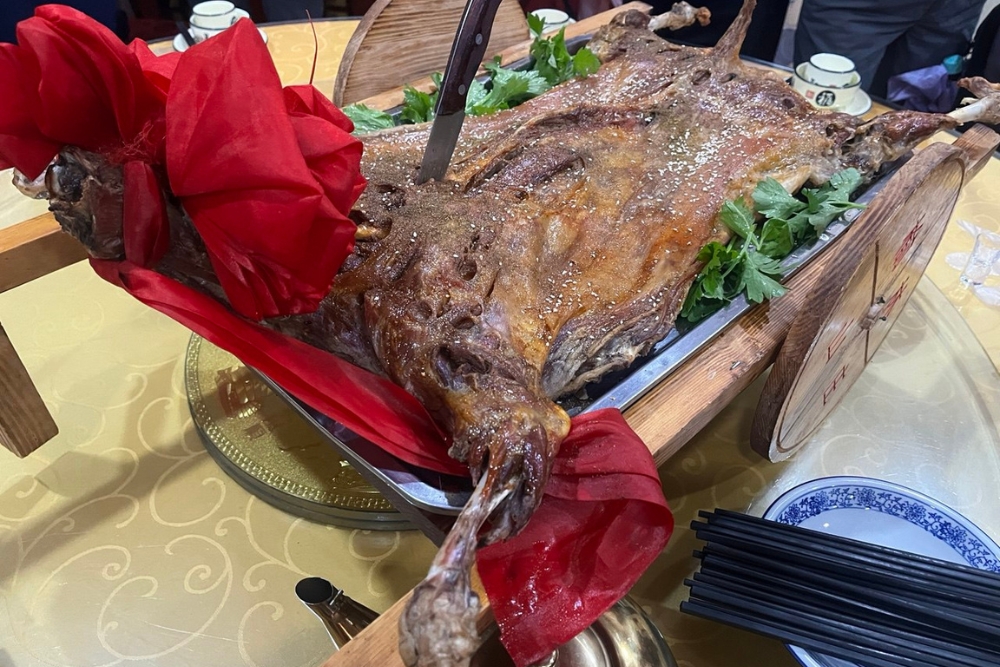
Credit: Valerie Valberg-Yeoh
We spent an eventful three days in Dunhuang – our last stop in Northwestern China – which culminated in savouring an entire roasted lamb for lunch.
We were at the westernmost part of the Silk Road by now, with the Gobi literally right beside us. Dunhuang is an oasis located at a religious and cultural crossroads on the Silk Road.
Just like Xining, Dunhuang’s strategic position on the ancient Southern Silk Road meant it controlled the entrance to the Hexi Corridor which leads to Xian and Luoyang.
The Dunhuang Museum tells the whole story and is worth a visit. On display at the Dunhuang museum are artifacts from over 2,000 years ago. I was taken in by a replica stone of the Han Great Wall showing a one-metre cube cross-section of the materials used.
Mogao Caves and Yardan National Geopark
The Mogao Caves are a must-see attraction of unmatched historical value. Also known as the Thousand Buddha Grottoes, they were constructed in 366AD. The 492 caves contain some of the finest examples of Buddhist art spanning 1,000 years.
Also impressive and just 180km northwest of Dunhuang are Yardan National Geopark’s unique rock formations that withstood wind erosion in the desert for over 700,000 years.
Said to be the largest and most mature landform cluster in the world, the desolate desert is also referred to as Devil City because of the eerie sounds made by the wind. And possibly the heat.
With hats and scarves we braved the scorching heat. We were grateful we zipped around the vast 398 square km of the geopark on a shuttle buggy and only stopped for 20 or 30 minutes at most to walk to the rock formations to take photographs.
Dunhuang Celebration Show
Our finale in Dunhuang was being part of The Dunhuang Celebration Show, a large-scale outdoor performance using the natural desert landscape and coupling it with technology to create an immersive showcase of Dunhuang’s history.
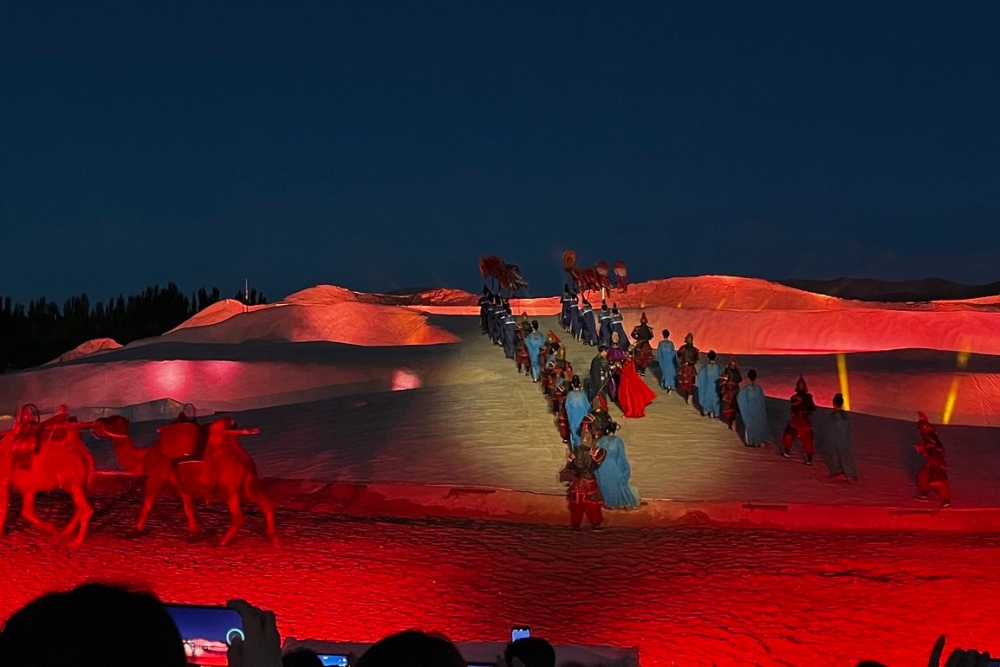
Credit: Valerie Valberg-Yeoh
We the audience were moved from set to set via the rotating platform we sat on, experiencing the cultural atmosphere of the Silk Road. It was a superb and surreal experience. The first scene blew us away like a sandstorm as it took place on a sand dune with real camels!
My final highlight was marvelling at the remains of the Great Wall of the Han Dynasty. I asked my guide in which direction Xinjiang was. He pointed. That was where we were headed: and it’s the second part of my adventure.
And thanks to China’s extensive network coverage of 45,000km by high-speed train, we only need take a two-hour coach ride to Liuyuan to catch the high-speed rail to Xinjiang. It took us 3.5 hours to reach Turpan in Xinjiang.
Continue with me on my journey into the lands of the Mongols brought under China’s reign: Xinjiang.
Bonus: Tips for travelling easy on the Silk Road
- Prepare for lots of walking and climbing
Expect a walking distance from coach to the ticket offices of attractions of between 200 and 400 metres. Be prepared to walk and climb slopes and stairs when you visit the attractions: Grottoes, geoparks, mountains, fortresses, temples, monasteries, and The Great Wall (the end of the western Ming Wall).
- Shield yourself from the elements
Wear wide-brimmed hats and sunglasses to shield from the sun. UV protection (sunscreen) is a must. Hats attached to a string that can be tightened are preferred because the winds can blow your hat away.
- Take along your meds and masks
High altitude sickness pills like Diamox (Acetazolamide) or natural remedies like Hong Jing Tian are good to have. Do check with your doctor on what is best for you. Masks can minimize the risk of catching colds and coughs. They are also necessary when sand storms approach.
- Travel light
Carry a medium-sized (24-inch) suitcase if you can (see here for some recommendations). This would make it far easier to board the high- speed trains.
There is limited baggage storage space so your bags would have to be lifted and stored above your seat. This can be a strain on your shoulders.
The train officials make periodic checks to ensure no bottles fall from side compartments of luggage but it would be best if you checked too.
- Dress right
Pack easy-to-wash wear like dri-fit tops. Long-sleeved UV tops which promise UPF50 protection are ideal. Long pants or tights protect against sun, sand, and the desert temperatures.
- Adapt to the diet
Expect good amounts of lamb and beef as well as ample vegetable dishes at meal times. Mantou and millet porridge are staples. Items like coffee and bread and butter are rarely served. You may want to bring your own coffee if you need caffeine. Your room should feature a kettle you can use.
- Bring toilet paper and handwash
Interestingly, toilet rolls are one-third the size we are accustomed to so you may want to BYO. Ample tissues are a must for the visits to the squatting loos.
One friend had to spray the tissue bin as she entered to minimise odours. We all made a beeline after her.
Another took a hotel shampoo bottle and filled it with liquid soap because it is almost never provided at toilet stops along the journey.



